The Human Life Journey: From Beginning to End
The Human Life Journey:
From Beginning to End
The human life journey is a complex and dynamic process,
encompassing various stages from birth to death. Each stage brings unique
experiences, challenges, and opportunities for growth. Here's an overview of
the human life journey, divided into several stages:
Stage 1: Infancy and
Early Childhood (0-5 years)
This stage is characterized by rapid physical and cognitive
development. Infants and young children learn to navigate their environment,
develop motor skills, and form attachments to caregivers.
Example:
A child's ability to
recognize and respond to familiar faces and voices demonstrates early cognitive
development.
Stage 2: Childhood and
Adolescence (6-18 years)
During this stage, children develop social skills, form
friendships, and begin to explore their interests and talents. Adolescence can
be a tumultuous time, marked by physical changes, emotional ups and downs, and
identity formation.
Example:
A teenager's involvement
in extracurricular activities, such as sports or music, can help them develop
teamwork and leadership skills.
Stage 3: Young
Adulthood (19-30 years)
Young adults typically pursue higher education, enter the
workforce, and establish their independence. This stage is marked by
exploration, self-discovery, and the formation of romantic relationships.
Example:
A young adult's decision
to pursue a career in a field they're passionate about can lead to a sense of
purpose and fulfilment.
Stage 4: Adulthood
(31-64 years)
During this stage, individuals often establish their careers,
build families, and contribute to their communities. Adults may face challenges
related to work-life balance, financial stability, and relationships.
Example:
A working parent's
ability to balance job responsibilities with family obligations can demonstrate
their ability to prioritize and manage multiple responsibilities.
Stage 5: Older
Adulthood (65+ years)
This stage is characterized by reflection, relaxation, and
often, a focus on legacy and relationships. Older adults may face challenges
related to health, cognitive decline, and social isolation.
Example:
A retiree's decision to
pursue hobbies or volunteer work can help them stay engaged, active, and
connected with their community.
The Journey's End:
Death and Legacy
The final stage of life is marked by the culmination of one's
experiences, relationships, and contributions. A person's legacy can live on
through their loved ones, work, and impact on their community.
Example:
A person's charitable
foundation or foundation established in their name can continue their
philanthropic work and benefit future generations.
Valuable Lessons from the Human Life
Journey
1. Resilience:
Life is filled with
challenges and setbacks, but resilience and adaptability are key to navigating
these difficulties.
2. Relationships:
Building and maintaining
strong relationships with family, friends, and community is essential for
emotional support and a sense of belonging.
3. Personal growth:
Embracing opportunities
for learning, self-improvement, and exploration can lead to a more fulfilling
life.
4. Purpose:
Discovering and pursuing
one's passions and values can give life meaning and direction.
5. Legacy:
Considering the impact
one wants to leave on the world can inspire meaningful contributions and a
sense of purpose.
The human life journey is a complex, dynamic, and
multifaceted experience. By understanding and embracing the various stages and
challenges of life, individuals can cultivate resilience, build meaningful
relationships, and leave a lasting legacy.
.jpeg)

.jpeg)
.jpeg)
.jpeg)


Very Nice
ReplyDeleteSO BEAUTIFUL
ReplyDeletegood story
ReplyDelete